A Modified Distributed CN-VSA Method for Mapping of the Seasonally Variable Source Areas
Abstract
1. Introduction
2. Materials and Methods
2.1. Description of the Watershed
2.2. Description of Distributed CN–VSA Method
2.3. Predicting the Saturated Fractional Area of the Watershed
- Q = Runoff depth in mm
- P = Rainfall in mm
- Ia = Rainfall retained in the watershed when runoff begins in mm
- S = Potential maximum retention in mm
2.4. Spatial Location of the Runoff-Generating Areas
2.5. Distributed CN-VSA Method
2.6. Modified Distributed CN-VSA Method
3. Results and Discussion
3.1. Application of Distributed CN-VSA Method
3.2. Application of the Modified Distributed CN-VSA Method
3.3. Comparison of Runoff Amounts Estimated by Distributed CN–VSA Method and Modified Distributed CN–VSA Method
3.4. Spatial Distribution of Runoff
4. Conclusions
Author Contributions
Funding
Data Availability Statement
Conflicts of Interest
References
- Dunne, T. Field studies of hillslope flow processes. Hillslope Hydrol. 1978, 227–293. [Google Scholar]
- Qiu, Z. Variable Source Pollution: Turning science into action to manage and protect critical source areas in landscapes. J. Soil Water Conserv. 2010, 65, 137A–141A. [Google Scholar] [CrossRef]
- Ward, R.C. On the response to precipitation of headwater streams in humid areas. J. Hydrol. 1984, 74, 171–189. [Google Scholar] [CrossRef]
- Cheng, X.; Shaw, S.B.; Marjerison, R.D.; Yearick, C.D.; Degloria, S.D.; Walter, M.T. Improving risk estimates of runoff producing areas: Formulating variable source areas as a bivariate process. J. Environ. Manag. 2014, 137, 146–156. [Google Scholar] [CrossRef]
- DeLay, E.; Gharabaghi, B. A review of low-grade weirs as an agri-environmental best management practice in the Elginfield Municipal Drain watershed, Ontario, Canada. J. Soil Water Conserv. 2018, 73, 42A–48A. [Google Scholar] [CrossRef]
- Niraula, R.; Kalin, L.; Srivastava, P.; Anderson, C.J. Identifying critical source areas of nonpoint source pollution with SWAT and GWLF. Ecol. Model. 2013, 268, 123–133. [Google Scholar] [CrossRef]
- Amanjot, S.; Rudra, R.P.; Ahmed, S.I.; Das, S.; Gharabaghi, B. Application of CANWET and HSPF for TMDL evaluation under Southern Ontario conditions. In Proceedings of the Watershed Management to Meet Water Quality Standards and TMDLS (Total Maximum Daily Load), San Antonio, TX, USA, 10–14 March 2007; American Society of Agricultural and Biological Engineers: St. Joseph, MI, USA, 2007; p. 35. [Google Scholar]
- Singh, A.; Rudra, R.P.; Gharabaghi, B. Evaluation of CANWET model for hydrologic simulations for upper Cana-gagigue Creek watershed in southern Ontario. Can. Biosyst. Eng. 2012, 54, 1.7–1.18. [Google Scholar] [CrossRef]
- Thompson, J.; Cassidy, R.; Doody, D.G.; Flynn, R. Predicting critical source areas of sediment in headwater catchments. Agric. Ecosyst. Environ. 2013, 179, 41–52. [Google Scholar] [CrossRef]
- Fiori, A.; Romanelli, M.; Cavalli, D.; Russo, D. Numerical experiments of streamflow generation in steep catchments. J. Hydrol. 2007, 339, 183–192. [Google Scholar] [CrossRef]
- Gevaert, A.I.; Teuling, A.J.; Uijlenhoet, R.; Delong, S.B.; Huxman, T.; Pangle, L.; Breshears, D.D.; Chorover, J.; Pelletier, J.D.; Saleska, S.R.; et al. Hillslope-scale experiment demonstrates the role of convergence during two-step saturation. Hydrol. Earth Syst. Sci. 2014, 18, 3681–3692. [Google Scholar] [CrossRef]
- Smith, R.E.; Goodrich, D.C. Rainfall Excess Overland Flow. In Encyclopedia of Hydrological Sciences; Wiley: Hoboken, NJ, USA, 2006. [Google Scholar]
- Clark, J.; Dunne, T.; Leopold, L.B. Water in Environmental Planning; Macmillan: Basingstoke, UK, 1978. [Google Scholar]
- Horton, R.E. The Role of infiltration in the hydrologic cycle. Trans. Am. Geophys. Union 1933, 14, 446–460. [Google Scholar] [CrossRef]
- Ahmed, S.I.; Rudra, R.P.; Gharabaghi, B.; MacKenzie, K.; Dickinson, W.T. Within-Storm Rainfall Distribution Effect on Soil Erosion Rate. Int. Sch. Res. Not. 2012, 2012, 1–7. [Google Scholar] [CrossRef]
- Frankenberger, J.R.; Brooks, E.S.; Walter, M.T.; Steenhuis, T.S. A GIS-based variable source area hydrology model. Hydrol. Process. 1999, 13, 805–822. [Google Scholar] [CrossRef]
- Todd, W.M.; Walter, M.F.; Brooks, E.S.; Steenhuis, T.S.; Boll, J.; Weiler, K. Hydrologically sensitive areas: Variable source area hydrology implications for water quality risk assessment. J. Soil Water Conserv. 2000, 55, 277–284. [Google Scholar]
- Das, S.; Rudra, R.; Goel, P.; Gharabaghi, B.; Gupta, N. Evaluation of AnnAGNPS in cold and temperate regions. Water Sci. Technol. 2006, 53, 263–270. [Google Scholar] [CrossRef] [PubMed]
- Chapi, K.; Rudra, R.P.; Ahmed, S.I.; Khan, A.A.; Gharabaghi, B.; Dickinson, W.T.; Goel, P.K. Spatial-Temporal Dynamics of Runoff Generation Areas in a Small Agricultural Watershed in Southern Ontario. J. Water Resour. Prot. 2015, 7, 14–40. [Google Scholar] [CrossRef]
- Amerman, C.R. The use of unit-Source watershed data for runoff prediction. Water Resour. Res. 1965, 1, 499–507. [Google Scholar] [CrossRef]
- Beven, K.J.; Kirkby, M.J. A physically based, variable contributing area model of basin hydrology/Un modèle à base physique de zone d’appel variable de l’hydrologie du bassin versant. Hydrol. Sci. Bull. 1979, 24, 43–69. [Google Scholar] [CrossRef]
- Wigmosta, S.M.; Vail, L.W.; Lettenmaier, D.P. A distributed hydrology-vegetation model for complex terrain. Water Resour. Res. 1994, 30, 1665–1679. [Google Scholar] [CrossRef]
- Steenhuis, T.; Van Der Molen, W. The Thornthwaite-Mather procedure as a simple engineering method to predict recharge. J. Hydrol. 1986, 84, 221–229. [Google Scholar] [CrossRef]
- Zollweg, J.A.; Gburek, W.J.; Steenhuis, T.S. SMoRMod—A GIS-integrated Rainfall-runoff Model. Trans. ASAE 1996, 39, 1299–1307. [Google Scholar] [CrossRef]
- Pradhan, N.R.; Ogden, F.L. Development of a one-parameter variable source area runoff model for ungauged basins. Adv. Water Resour. 2010, 33, 572–584. [Google Scholar] [CrossRef]
- Easton, Z.M.; Fuka, D.R.; Walter, M.T.; Cowan, D.M.; Schneiderman, E.M.; Steenhuis, T.S. Re-conceptualizing the soil and water assessment tool (SWAT) model to predict runoff from variable source areas. J. Hydrol. 2008, 348, 279–291. [Google Scholar] [CrossRef]
- Schneiderman, M.E.; Steenhuis, T.S.; Thongs, D.J.; Easton, Z.M.; Zion, M.S.; Neal, A.L.; Mendoza, G.F.; Walter, M.T. Incorporating variable source area hydrology into a curve-number-based watershed model. Hydrol. Process. Int. J. 2007, 21, 3420–3430. [Google Scholar] [CrossRef]
- Liu, Y.; Yang, W.; Yu, Z.; Lung, I.; Gharabaghi, B. Estimating Sediment Yield from Upland and Channel Erosion at A Watershed Scale Using SWAT. Water Resour. Manag. 2015, 29, 1399–1412. [Google Scholar] [CrossRef]
- Gupta, A.; Rudra, R.; Gharabahi, B.; Daggupati, P.; Goel, P.; Shukla, R. Predicting the Impact of Drainage Ditches upon Hydrology and Sediment Loads Using KINEROS 2 Model: A Case Study in Ontario. Can. Biosyst. Eng. 2018, 60, 1.1–1.15. [Google Scholar] [CrossRef]
- Gupta, A.K.; Rudra, R.P.; Gharabaghi, B.; Goel, P.K.; Sebti, S.; Shukla, R.; Daggupati, P. A Modeling Approach for Evaluating Watershed-scale Water Quality Benefits of Vegetative Filter Strip—A Case Study in Ontario. Appl. Eng. Agric. 2019, 35, 271–281. [Google Scholar] [CrossRef]
- Jason, M. Testing a Method for Predicting Variable Source Areas of Runoff Generation. Master’s Thesis, Cornell University, Ithaca, NY, USA, 2008. [Google Scholar]
- Collick, A.S.; Fuka, D.R.; Kleinman, P.J.A.; Buda, A.R.; Weld, J.L.; White, M.J.; Veith, T.L.; Bryant, R.B.; Bolster, C.H.; Easton, Z.M. Predicting phosphorus dynamics in complex terrains using a variable source area hydrology model. Hydrol. Process. 2015, 29, 588–601. [Google Scholar] [CrossRef]
- Mishra, S.K.; Singh, V.P. Soil Conservation Service Curve Number (SCS-CN) Methodology; Springer Science & Business Media: Berlin, Germany, 2003; Volume 42. [Google Scholar]
- Mishra, S.K.; Singh, V.P. Long-term hydrological simulation based on the Soil Conservation Service curve number. Hydrol. Process. 2004, 18, 1291–1313. [Google Scholar] [CrossRef]
- Mishra, S.K.; Jain, M.K.; Bhunya, P.K.; Singh, V.P. Field Applicability of the SCS-CN-Based Mishra?Singh General Model and its Variants. Water Resour. Manag. 2005, 19, 37–62. [Google Scholar] [CrossRef]
- Ponce, V.M.; Hawkins, R.H. Runoff Curve Number: Has It Reached Maturity? J. Hydrol. Eng. 1996, 1, 11–19. [Google Scholar] [CrossRef]
- Soulis, K.X.; Valiantzas, J.D.; Dercas, N.; Londra, P.A. Analysis of the runoff generation mechanism for the investigation of the SCS-CN method applicability to a partial area experimental watershed. Hydrol. Earth Syst. Sci. Discuss. 2009, 6, 1. [Google Scholar]
- Qiu, Z.; Walter, M.T.; Hall, C. Managing variable source pollution in agricultural watersheds. J. Soil Water Conserv. 2007, 62, 115–122. [Google Scholar]
- Steenhuis, S.T.; Winchell, M.; Rossing, J.; Zollweg, J.A.; Walter, M.F. SCS runoff equation revisited for variable-source runoff areas. J. Irrig. Drain. Eng. 1995, 121, 234–238. [Google Scholar] [CrossRef]
- Lyon, S.W.; Walter, M.T.; Gérard-Marchant, P.; Steenhuis, T.S. Using a topographic index to distribute variable source area runoff predicted with the SCS curve-number equation. Hydrol. Process. 2004, 18, 2757–2771. [Google Scholar] [CrossRef]
- Soulis, K.X.; Valiantzas, J.D. SCS-CN parameter determination using rainfall-runoff data in heterogeneous water-sheds—The two-CN system approach. Hydrol. Earth Syst. Sci. 2012, 16, 1001–1015. [Google Scholar] [CrossRef]
- Wall, G.J. Temporal pattern of erosion and fluvial sedimentation in the Great Lakes Basin. Geosci. Can. 1976, 3, 158–163. [Google Scholar]
- Detty, J.M.; McGuire, K.J. Topographic controls on shallow groundwater dynamics: Implications of hydrologic connectivity between hillslopes and riparian zones in a till mantled catchment. Hydrol. Process. 2010, 24, 2222–2236. [Google Scholar] [CrossRef]
- Hewlett, D.J.; Hibbert, A.R. Factors affecting the response of small watersheds to precipitation in humid areas. For. Hydrol. 1967, 1, 275–290. [Google Scholar]
- Anderson, M.G.; Kneale, P.E. The influence of low-angled topography on hillslope soil-water convergence and stream discharge. J. Hydrol. 1982, 57, 65–80. [Google Scholar] [CrossRef]
- O’Loughlin, E.M. Prediction of Surface Saturation Zones in Natural Catchments by Topographic Analysis. Water Resour. Res. 1986, 22, 794–804. [Google Scholar] [CrossRef]
- Rodríguez-Iturbe, I.; Valdés, J.B. The geomorphologic structure of hydrologic response. Water Resour. Res. 1979, 15, 1409–1420. [Google Scholar] [CrossRef]
- Xue, L.; Bao, R.; Meixner, T.; Yang, G.; Zhang, J. Influences of topographic index distribution on hydrologically sensitive areas in agricultural watershed. Stoch. Environ. Res. Risk Assess. 2014, 28, 2235–2242. [Google Scholar] [CrossRef]
- Hassan, Q.K.; Bourque, C.P.-A.; Meng, F.-R.; Cox, R.M. A Wetness Index Using Terrain-Corrected Surface Temperature and Normalized Difference Vegetation Index Derived from Standard MODIS Products: An Evaluation of Its Use in a Humid Forest-Dominated Region of Eastern Canada. Sensors 2007, 7, 2028–2048. [Google Scholar] [CrossRef] [PubMed]
- Moore, D.I.; Gessler, P.E.; Nielsen, G.A.E.; Peterson, G.A. Soil attribute prediction using terrain analysis. Soil Sci. Soc. Am. J. 1993, 57, 443–452. [Google Scholar] [CrossRef]
- Western, A.W.; Grayson, R.B.; Blöschl, G.; Willgoose, G.R.; McMahon, T.A. Observed spatial organization of soil moisture and its relation to terrain indices. Water Resour. Res. 1999, 35, 797–810. [Google Scholar] [CrossRef]
- Yong, B.; Ren, L.-L.; Hong, Y.; Gourley, J.J.; Chen, X.; Zhang, Y.-J.; Yang, X.-L.; Zhang, Z.-X.; Wang, W.-G. A novel multiple flow direction algorithm for computing the topographic wetness index. Hydrol. Res. 2012, 43, 135–145. [Google Scholar] [CrossRef]
- Hawkins, H.R.; Ward, T.J.; Woodward, D.E.; van Mullem, J.A. (Eds.) Curve Number Hydrology: State of the Practice; American Society of Civil Engineers: Reston, VA, USA, 2008. [Google Scholar]
- USDA; SCSCN. Soil Conservation Service National Engineering Handbook; United States Department of Agriculture: Washington, DC, USA, 1972.
- Mockus, V. Estimation of total (and peak rates of) surface runoff for individual storms. Exhibit A in Appendix B. In Terims Survey Report (Neosho) River Watershed; USDA: Washington, DC, USA, 1949. [Google Scholar]
- Boughton, W.; Stone, J. Variation of runoff with watershed area in a semi-arid location. J. Arid. Environ. 1985, 9, 13–25. [Google Scholar] [CrossRef]
- Shaw, S.B.; Walter, M.T. Improving runoff risk estimates: Formulating runoff as a bivariate process using the SCS curve number method. Water Resour. Res. 2009, 45, wr006900. [Google Scholar] [CrossRef]
- Ling, L.; Yusop, Z. A micro focus with macro impact: Exploration of initial abstraction coefficient ratio (λ) in Soil Conservation Curve Number (CN) methodology. IOP Conf. Ser. Earth Environ. Sci. 2014, 18, 012121. [Google Scholar] [CrossRef]
- Grabs, T.; Seibert, J.; Bishop, K.; Laudon, H. Modeling spatial patterns of saturated areas: A comparison of the topographic wetness index and a dynamic distributed model. J. Hydrol. 2009, 373, 15–23. [Google Scholar] [CrossRef]
- Mukherjee, S.; Mukherjee, S.; Garg, R.; Bhardwaj, A.; Raju, P.L.N. Evaluation of topographic index in relation to terrain roughness and DEM grid spacing. J. Earth Syst. Sci. 2013, 122, 869–886. [Google Scholar] [CrossRef]
- Qin, C.-Z.; Zhu, A.-X.; Pei, T.; Li, B.-L.; Scholten, T.; Behrens, T.; Zhou, C.-H. An approach to computing topographic wetness index based on maximum downslope gradient. Precis. Agric. 2011, 12, 32–43. [Google Scholar] [CrossRef]
- Sörensen, R.; Zinko, U.; Seibert, J. On the calculation of the topographic wetness index: Evaluation of different methods based on field observations. Hydrol. Earth Syst. Sci. 2006, 10, 101–112. [Google Scholar] [CrossRef]
- Kirkby, J.M.; Weyman, D.R. Measurements of Contributing Area in Very Small Drainage Basins; University of Bristol, Department of Geography: Bristol, UK, 1971. [Google Scholar]
- Barling, R.D.; Grayson, R.B.; Moore, I.D. A quasi-dynamic wetness index for characterizing the spatial distribution of zones of surface saturation and soil water content. Water Resour. Res. 1994, 30, 1029–1044. [Google Scholar] [CrossRef]
- Hjerdt, K.N.; McDonnell, J.J.; Seibert, J.; Rodhe, A. A new topographic index to quantify downslope controls on local drainage. Water Resour. Res. 2004, 40, wr003130. [Google Scholar] [CrossRef]
- Florinsky, I.V. Digital Terrain Analysis in Soil Science and Geology; Academic Press: Amsterdam, The Netherlands, 2012; 379p. [Google Scholar]
- Quinn, P.F.; Beven, K.J.; Lamb, R. The in(a/tan/β) index: How to calculate it and how to use it within the topmodel framework. Hydrol. Process. 1995, 9, 161–182. [Google Scholar] [CrossRef]
- Alberto, P. GIS Based Chemical Fate Modeling: Principles and Applications; John Wiley & Sons: Hoboken, NJ, USA, 2014. [Google Scholar]
- Buchanan, B.; Easton, Z.M.; Schneider, R.; Walter, M.T. Incorporating Variable Source Area Hydrology into a Spatially Distributed Direct Runoff Model 1. JAWRA J. Am. Water Resour. Assoc. 2012, 48, 43–60. [Google Scholar] [CrossRef]
- Wolock, D.M.; McCabe, G.J. Comparison of Single and Multiple Flow Direction Algorithms for Computing Topographic Parameters in TOPMODEL. Water Resour. Res. 1995, 31, 1315–1324. [Google Scholar] [CrossRef]
- Kishorkumar, P. Mapping and Modeling of Variable Source Areas in a Small Agricultural Watershed. Ph.D. Thesis, University of Guelph, Guelph, ON, Canada, 2015. [Google Scholar]
- Lindsay, J. Whitebox Geospatial Analysis Tools; The University of Guelph: Guelph, ON, Canada, 2009. [Google Scholar]
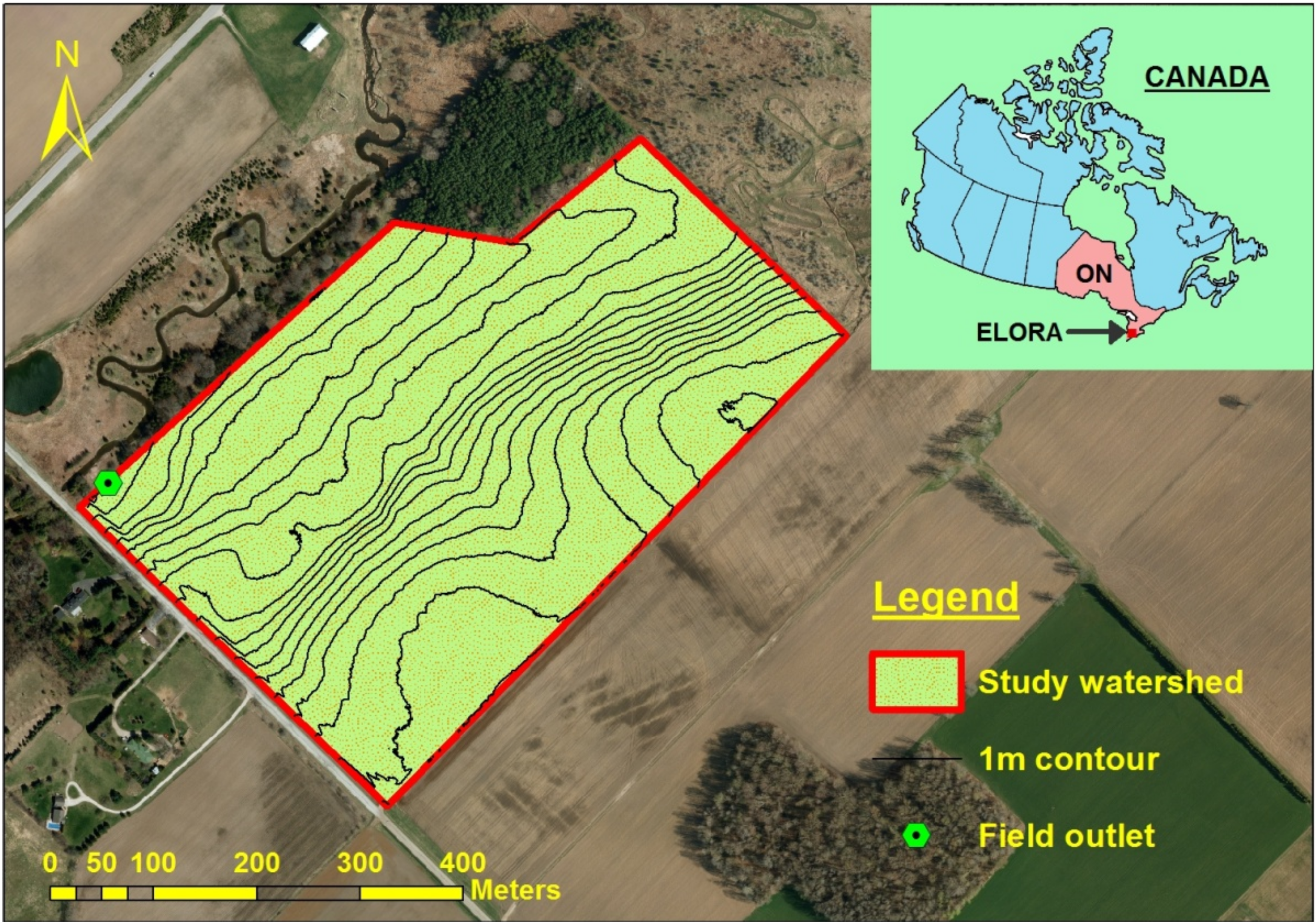


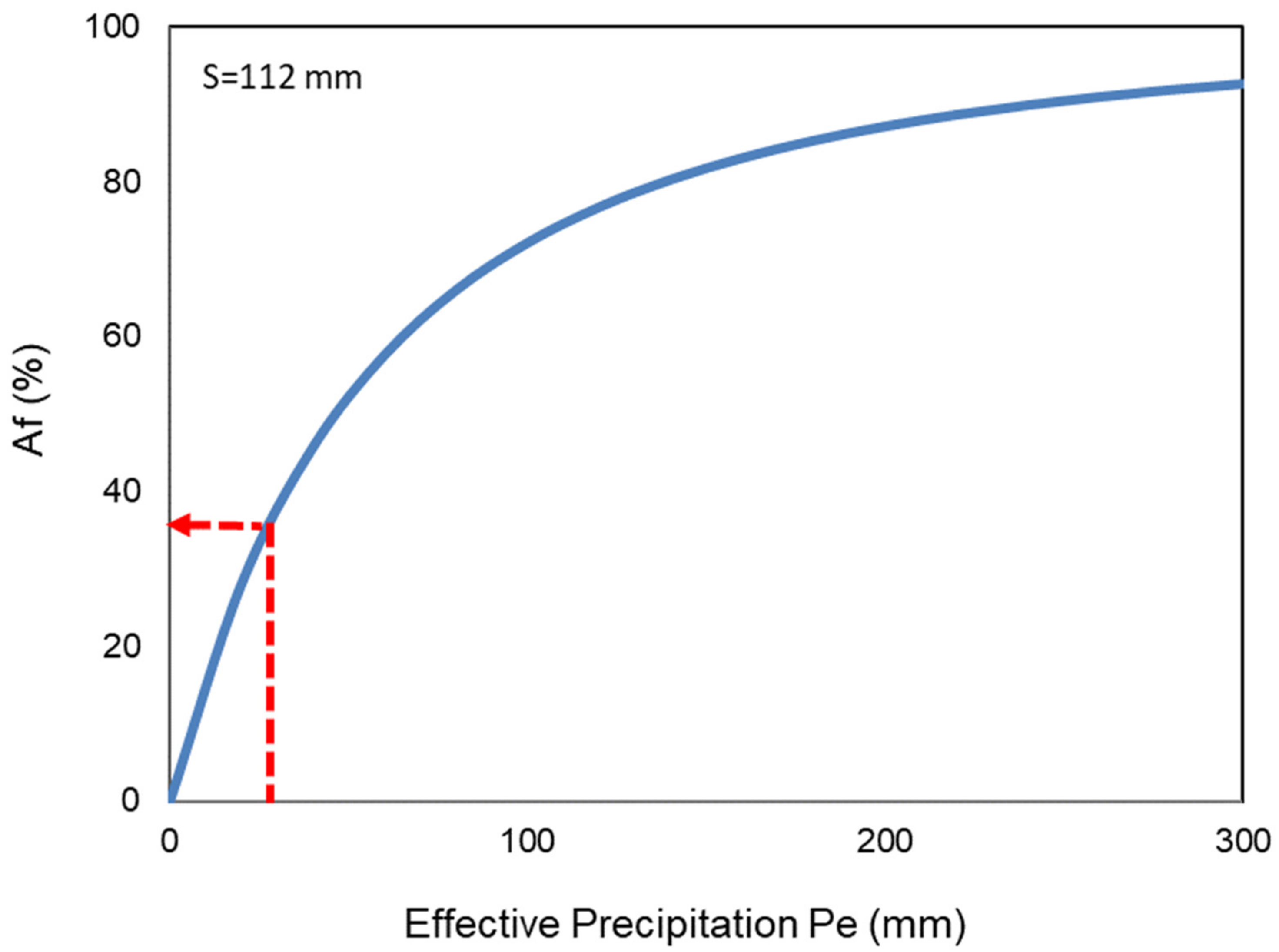
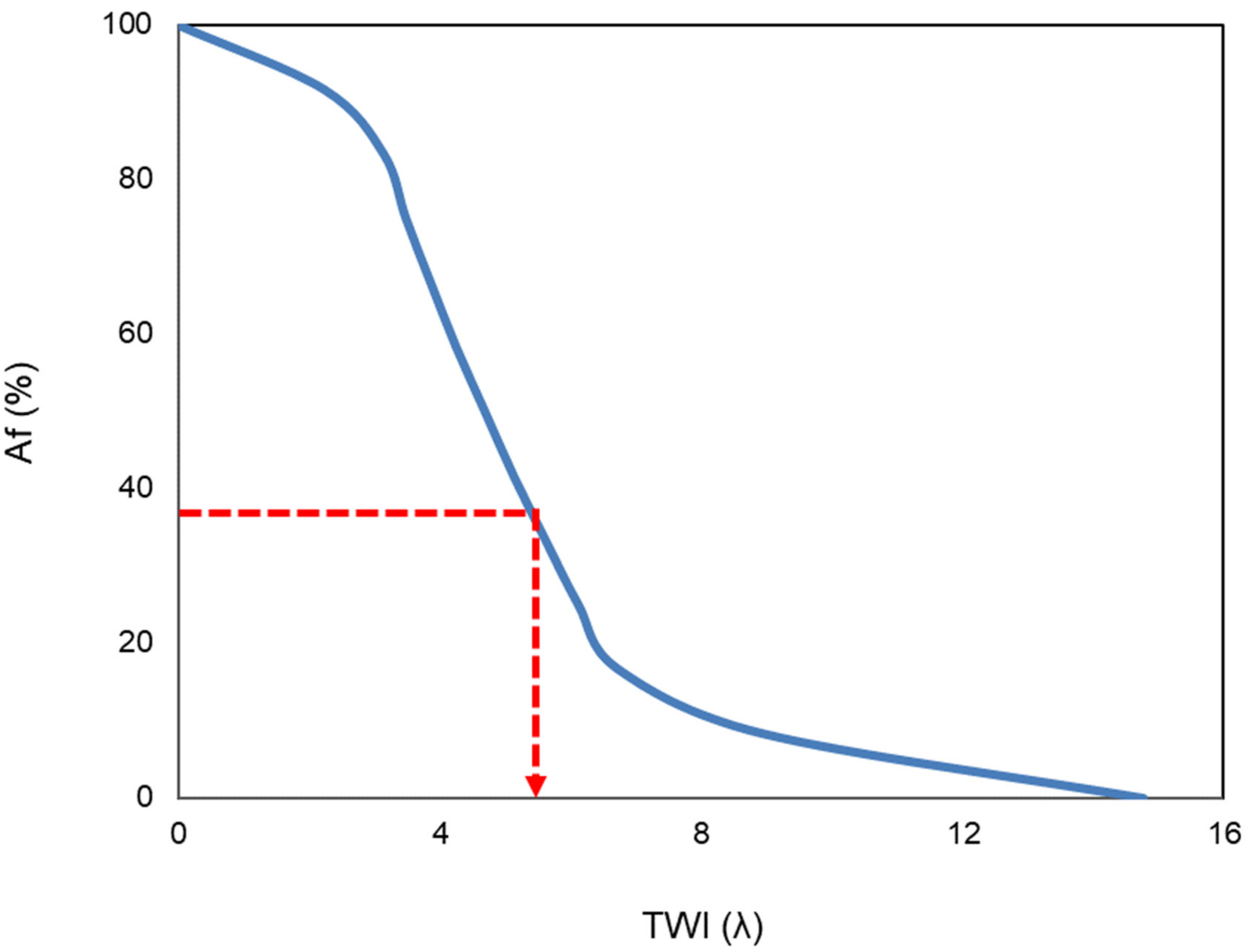
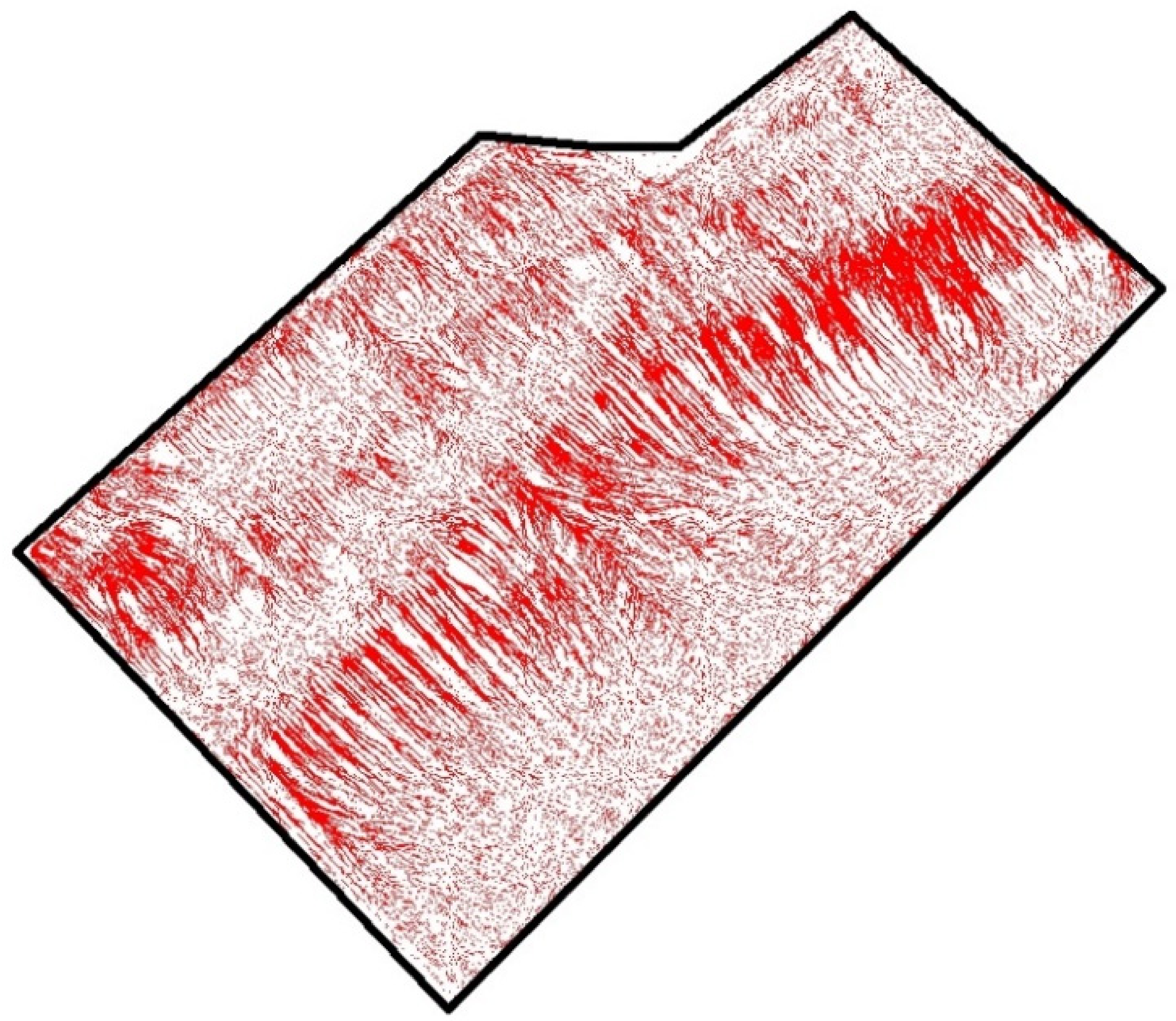

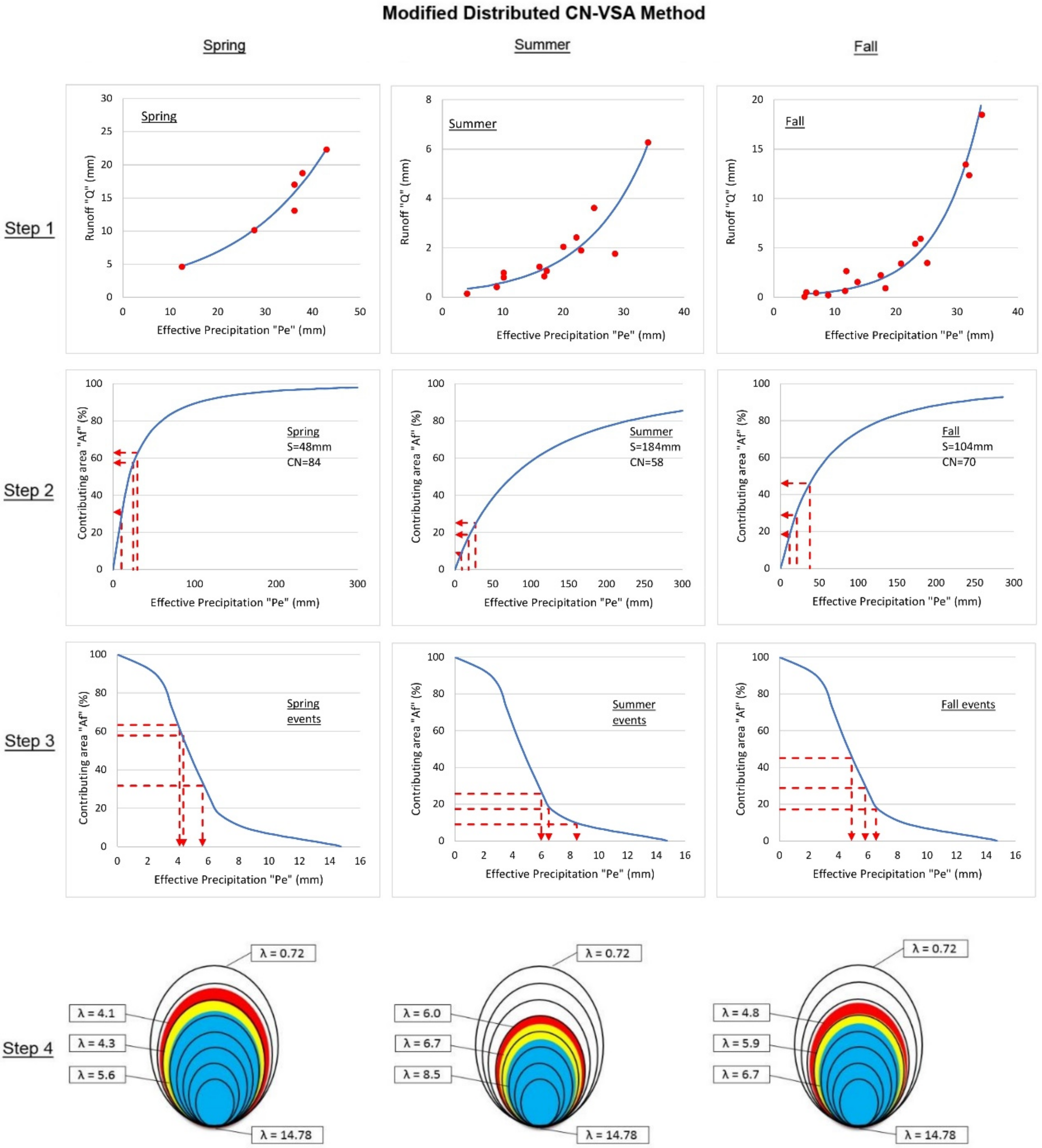

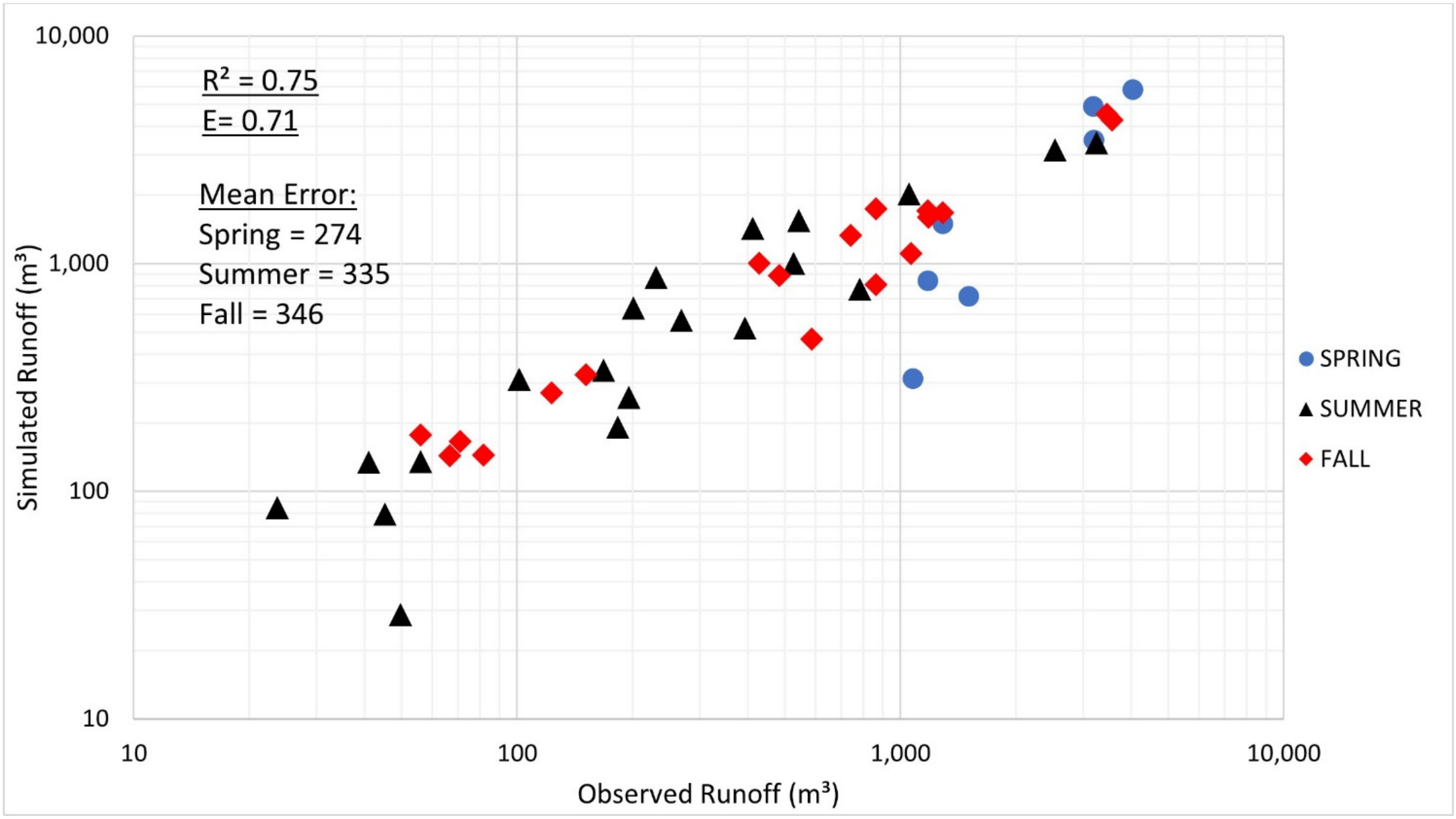
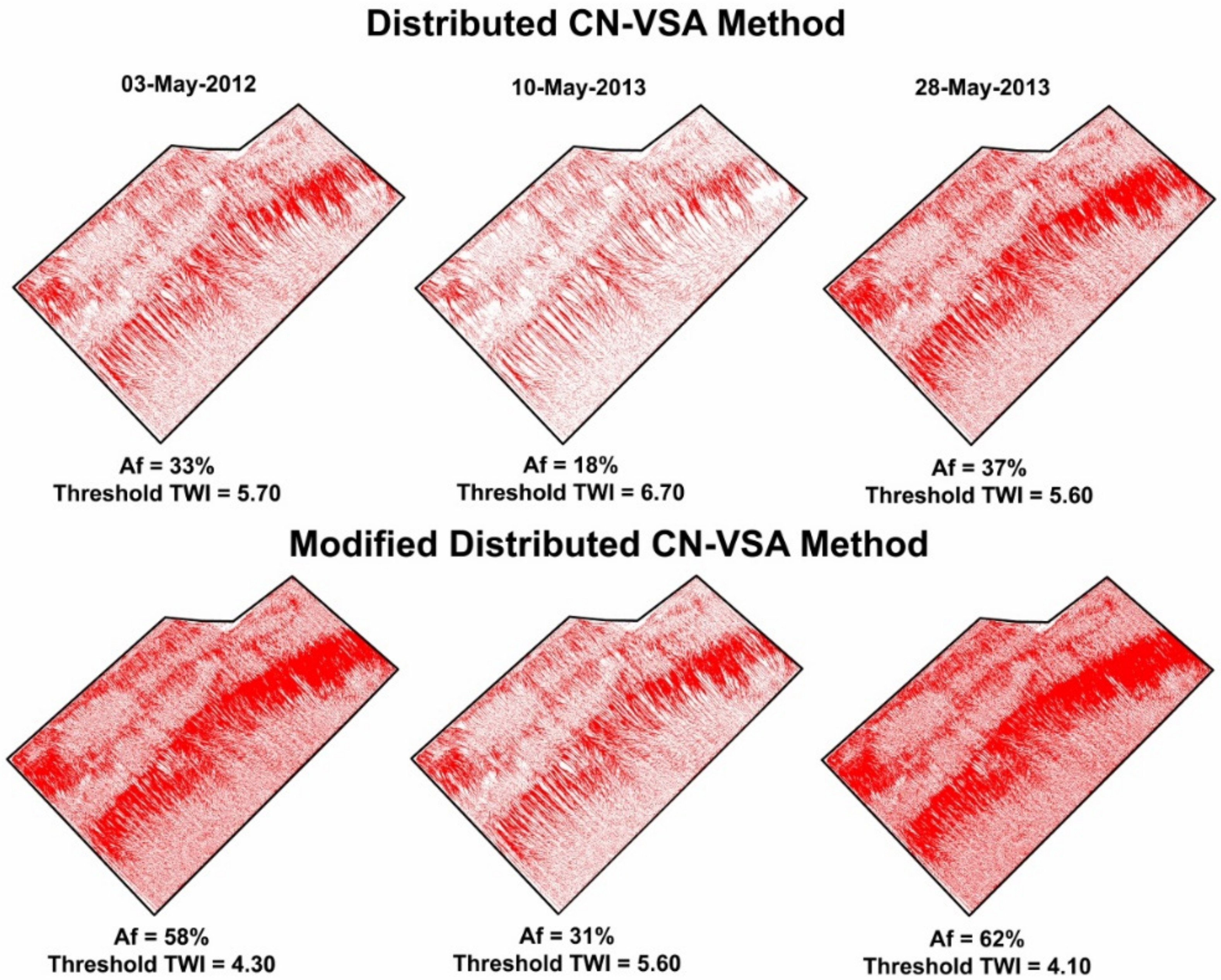
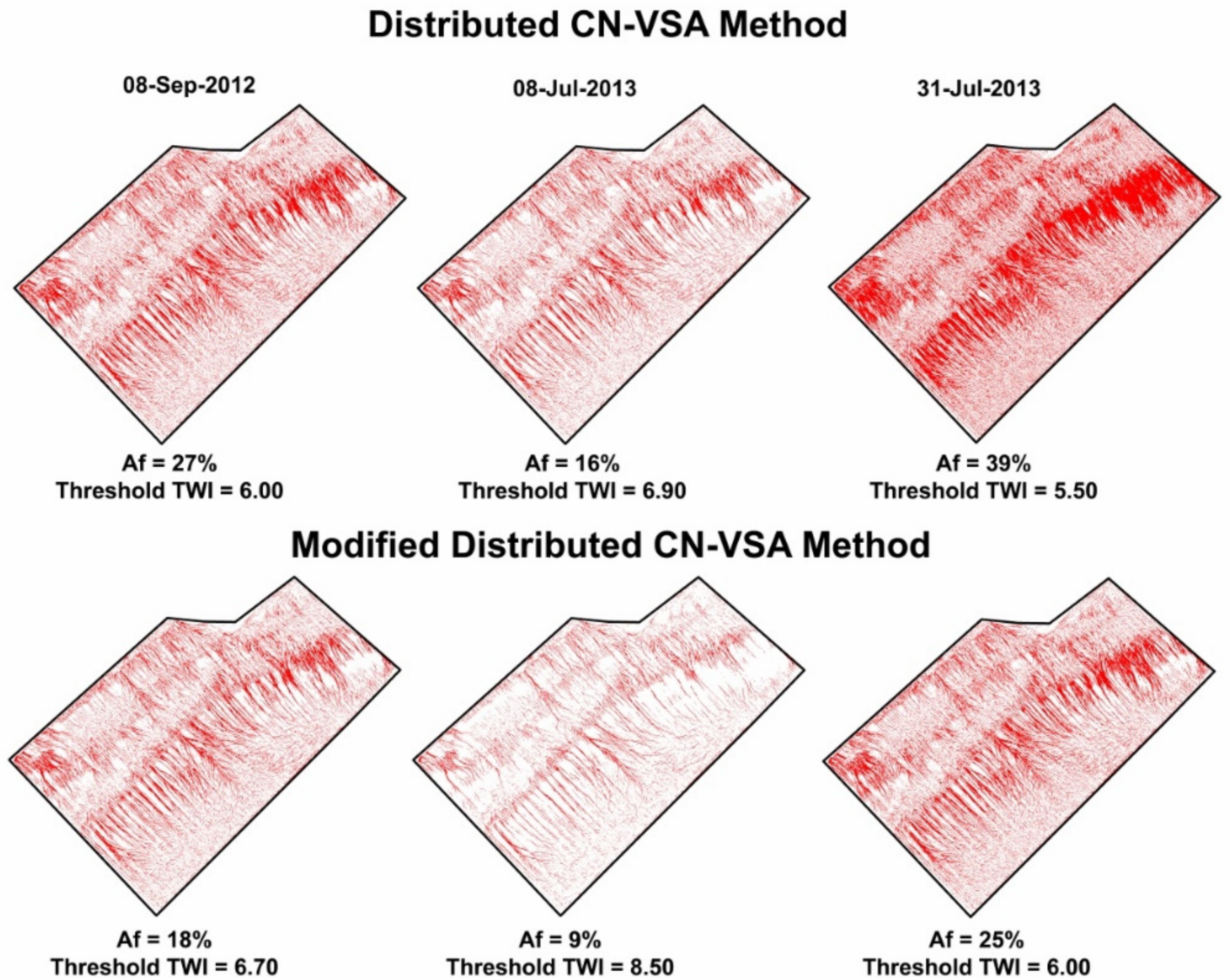
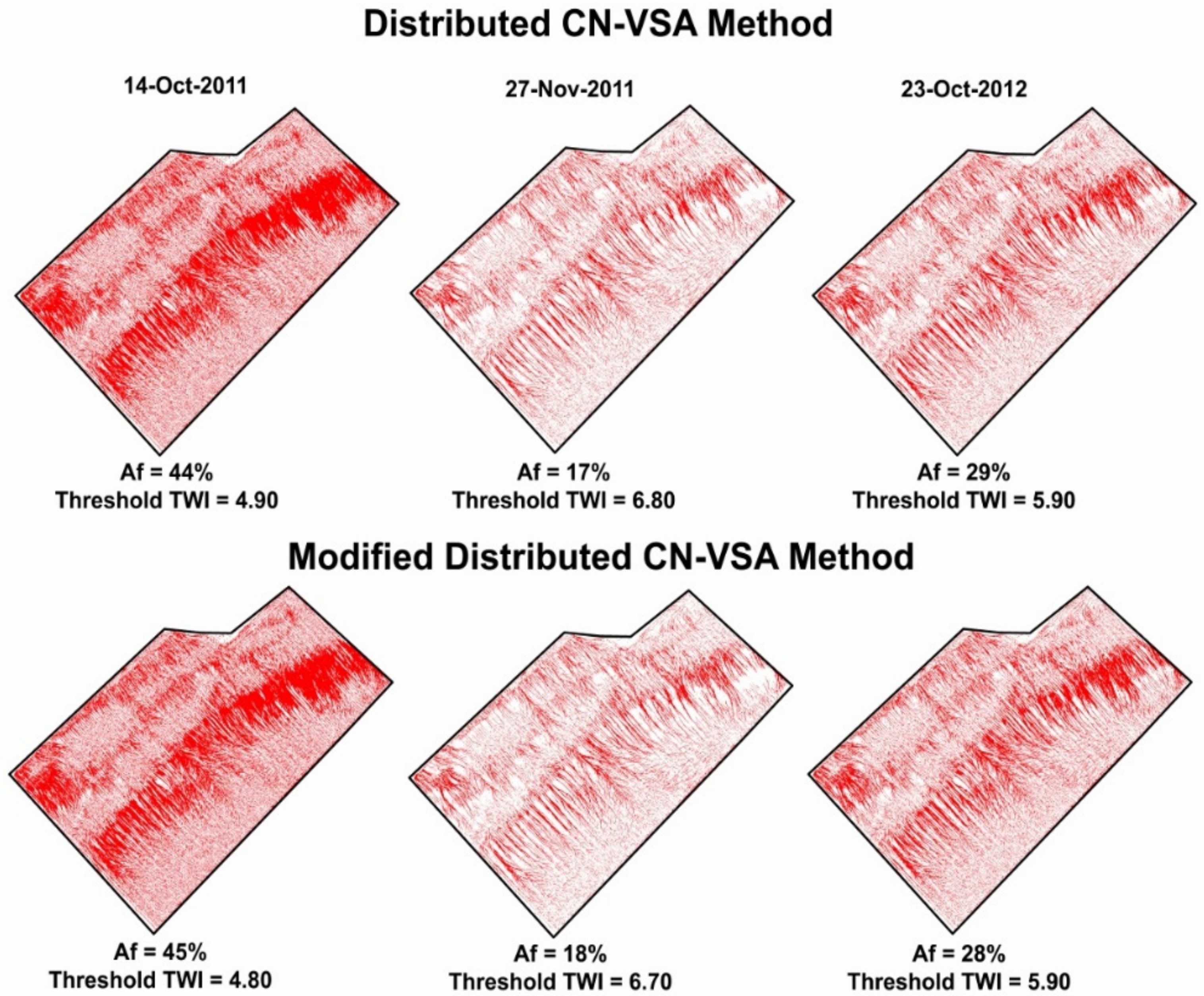
| Date | Obs. | Distributed CN-VSA Method | Mod. Distributed CN-VSA Method | ||||||||
|---|---|---|---|---|---|---|---|---|---|---|---|
| Pe [a] | Q [b] | S [c] | Af [d] | Q | Mean Error | S | Af | Q | Mean Error | ||
| (mm) | (m3) | (mm) | (%) | (m3) | (mm) | (%) | (m3) | ||||
| Spring | |||||||||||
| 3-May-12 | 27.52 | 3214 | 112 | 33 | 1963 | −752 | 48 | 58 | 3451 | 511 | |
| 10-May-13 | 12.37 | 1180 | 112 | 18 | 481 | 48 | 31 | 829 | |||
| 28-May-13 | 36.14 | 3196 | 112 | 37 | 2891 | 48 | 62 | 4844 | |||
| Summer | |||||||||||
| 8-September-12 | 20.65 | 784 | 112 | 27 | 1205 | 513 | 184 | 18 | 804 | 352 | |
| 8-July-13 | 10.12 | 183 | 112 | 16 | 350 | 184 | 9 | 197 | |||
| 31-July-13 | 30.76 | 1056 | 112 | 39 | 2594 | 184 | 25 | 2112 | |||
| Fall | |||||||||||
| 14-October-11 | 43.48 | 3596 | 112 | 44 | 4136 | 303 | 104 | 45 | 4230 | 358 | |
| 27-November-11 | 11.89 | 586 | 112 | 17 | 437 | 104 | 18 | 463 | |||
| 23-October-12 | 20.85 | 745 | 112 | 28 | 1262 | 104 | 29 | 1307 | |||
Publisher’s Note: MDPI stays neutral with regard to jurisdictional claims in published maps and institutional affiliations. |
© 2021 by the authors. Licensee MDPI, Basel, Switzerland. This article is an open access article distributed under the terms and conditions of the Creative Commons Attribution (CC BY) license (https://creativecommons.org/licenses/by/4.0/).
Share and Cite
Panjabi, K.; Rudra, R.; Goel, P.; Ahmed, S.; Gharabaghi, B. A Modified Distributed CN-VSA Method for Mapping of the Seasonally Variable Source Areas. Water 2021, 13, 1270. https://doi.org/10.3390/w13091270
Panjabi K, Rudra R, Goel P, Ahmed S, Gharabaghi B. A Modified Distributed CN-VSA Method for Mapping of the Seasonally Variable Source Areas. Water. 2021; 13(9):1270. https://doi.org/10.3390/w13091270
Chicago/Turabian StylePanjabi, Kishore, Ramesh Rudra, Pradeep Goel, Syed Ahmed, and Bahram Gharabaghi. 2021. "A Modified Distributed CN-VSA Method for Mapping of the Seasonally Variable Source Areas" Water 13, no. 9: 1270. https://doi.org/10.3390/w13091270
APA StylePanjabi, K., Rudra, R., Goel, P., Ahmed, S., & Gharabaghi, B. (2021). A Modified Distributed CN-VSA Method for Mapping of the Seasonally Variable Source Areas. Water, 13(9), 1270. https://doi.org/10.3390/w13091270







